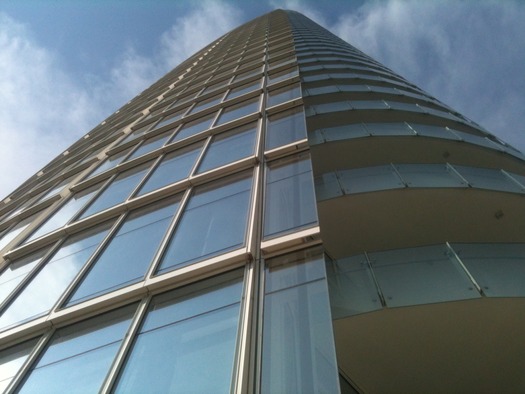
In a now classic post on bldgblog, Geoff Manaugh coined the term "Nakatomi Space," a reference to the action film Die Hard, in which supercop John McLain navigates a fictional L.A. skyscraper (the Nakatomi Building) through its infrastructure, suggesting an alternate and largely invisible urban environment that we rarely think about. (This is a corollary to what I have described as the Foundry Principle, the action-picture imperative, reaching back to the 1960s but de rigeur since The Terminator, to set final altercations in industrial spaces.) But I digress.
With a nod to Manaugh, in a review this weekend of Dallas's notoriously reflective Museum Tower I suggest my own term, High Net Space, or HNS, to describe the new International Style of the moneyed elite:
The lobby is cool and limpid and pristine, a professional execution of an aesthetic — call it High Net Space — characterized by expensive materials and blandly minimalist good taste. Here, HNS is translated here into a quarry’s worth of white marble, its veins oriented toward elevators that travel at 1,200 feet per minute — reportedly the fastest in the city — and open directly into the residences, a handy convenience.I don't know if it will catch on, but it is an improvement on the flawed nomenclature we now resort to. Citing the same trend in his recent Cronocaos exhibition, Rem Koolhaas — who knows a thing or two about the subject — gave us this aphorism: "Minimalism remains the preferred mode of conspicuous consumption."
We all know what he means, basically, but at this point the term "minimalism" has been used so broadly as to become almost meaningless. There was a time when the architectural aesthetic was tied, at least tangentially, to the conceptual art movement. Now "minimalism" can be used to describe a 10,000 square-foot beach house. There's nothing minimal about that.
—@marklamster


Comments [2]
And then there's Die Hard 12: Die Hungry. "Paper or plastic you son of a ___!"
It is funny that the Museum Tower in Dallas would see I.M. Pei as an inspiration; that's very thin ice to be walking on. Obviously Nakatomi (or Fox Tower) is a kind of bland, sensory depriving style. Every movement seems to catalyze inferior copies, that claim the original brand, but live by their own particular realities and choices.
The meanest girls are usually the ones that aren't as pretty as they think they are. At the same time the Museum Tower, as well as every so-called modern architect today, seems to be easy targets for increasingly petty issues like light refraction and the same 'elitist' critique that falls on all new buildings. It's hard to trust anything nowadays when Jimmy Kimmel could be lurking behind the closed door.
What is lacking in much of these buildings is that combination of modern with the romantic. Perhaps BIG's W57 will solve a bit of this dilemma, though many times it seems like just another new brand of modernism, this time moved even further into material realities into marketing gimmicks and computer diagrams. The same elitist socio-political substance wrapped in a new overwrought intellectual fashion? The only guarantee is that there will be hype and a lot of catchphrases. But at least BIG is trying to build his fictions, instead of fetishizing techno-fiction like BLDGBLOG.
09.11.13
05:19
09.15.13
07:25